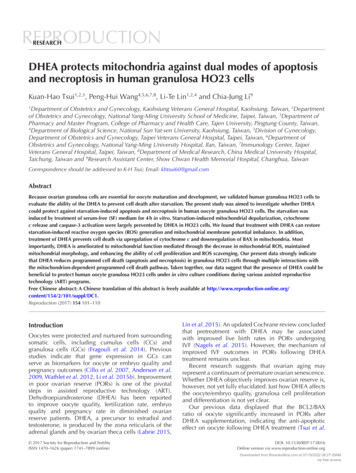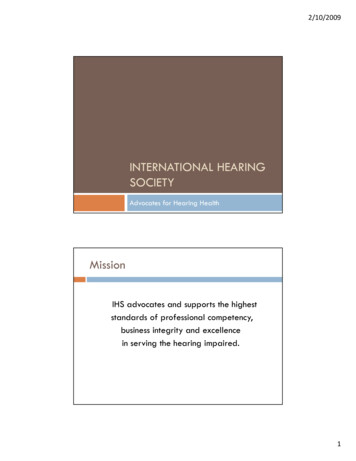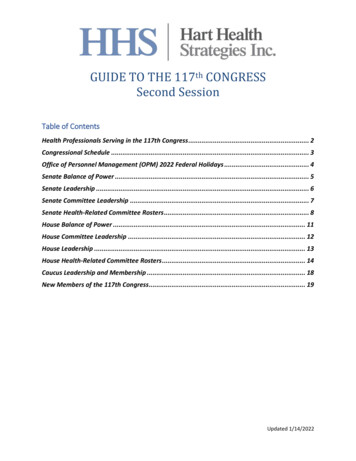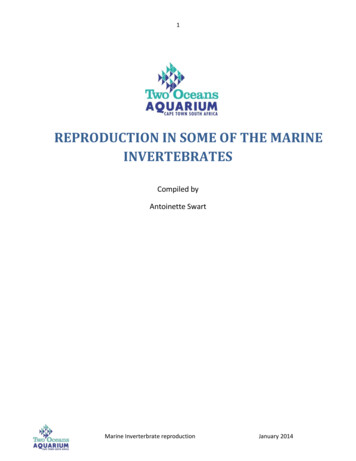
Transcription
REPRODUCTIONRESEARCHDHEA protects mitochondria against dual modes of apoptosisand necroptosis in human granulosa HO23 cellsKuan-Hao Tsui1,2,3, Peng-Hui Wang4,5,6,7,8, Li-Te Lin1,2,4 and Chia-Jung Li91Department of Obstetrics and Gynecology, Kaohsiung Veterans General Hospital, Kaohsiung, Taiwan, 2Departmentof Obstetrics and Gynecology, National Yang-Ming University School of Medicine, Taipei, Taiwan, 3Department ofPharmacy and Master Program, College of Pharmacy and Health Care, Tajen University, Pingtung County, Taiwan,4Department of Biological Science, National Sun Yat-sen University, Kaohsiung, Taiwan, 5Division of Gynecology,Department of Obstetrics and Gynecology, Taipei Veterans General Hospital, Taipei, Taiwan, 6Department ofObstetrics and Gynecology, National Yang-Ming University Hospital, Ilan, Taiwan, 7Immunology Center, TaipeiVeterans General Hospital, Taipei, Taiwan, 8Department of Medical Research, China Medical University Hospital,Taichung, Taiwan and 9Research Assistant Center, Show Chwan Health Memorial Hospital, Changhua, TaiwanCorrespondence should be addressed to K-H Tsui; Email: khtsui60@gmail.comAbstractBecause ovarian granulosa cells are essential for oocyte maturation and development, we validated human granulosa HO23 cells toevaluate the ability of the DHEA to prevent cell death after starvation. The present study was aimed to investigate whether DHEAcould protect against starvation-induced apoptosis and necroptosis in human oocyte granulosa HO23 cells. The starvation wasinduced by treatment of serum-free (SF) medium for 4 h in vitro. Starvation-induced mitochondrial depolarization, cytochromec release and caspase-3 activation were largely prevented by DHEA in HO23 cells. We found that treatment with DHEA can restorestarvation-induced reactive oxygen species (ROS) generation and mitochondrial membrane potential imbalance. In addition,treatment of DHEA prevents cell death via upregulation of cytochrome c and downregulation of BAX in mitochondria. Mostimportantly, DHEA is ameliorated to mitochondrial function mediated through the decrease in mitochondrial ROS, maintainedmitochondrial morphology, and enhancing the ability of cell proliferation and ROS scavenging. Our present data strongly indicatethat DHEA reduces programmed cell death (apoptosis and necroptosis) in granulosa HO23 cells through multiple interactions withthe mitochondrion-dependent programmed cell death pathway. Taken together, our data suggest that the presence of DHEA could bebeneficial to protect human oocyte granulosa HO23 cells under in vitro culture conditions during various assisted reproductivetechnology (ART) programs.Free Chinese abstract: A Chinese translation of this abstract is freely available at 01/suppl/DC1.Reproduction (2017) 154 101–110IntroductionOocytes were protected and nurtured from surroundingsomatic cells, including cumulus cells (CCs) andgranulosa cells (GCs) (Fragouli et al. 2014). Previousstudies indicate that gene expression in GCs canserve as biomarkers for oocyte or embryo quality andpregnancy outcomes (Cillo et al. 2007, Anderson et al.2009, Wathlet et al. 2012, Li et al. 2015b). Improvementin poor ovarian reserve (PORs) is one of the pivotalsteps in assisted reproductive technology (ART).Dehydroepiandrosterone (DHEA) has been reportedto improve oocyte quality, fertilization rate, embryoquality and pregnancy rate in diminished ovarianreserve patients. DHEA, a precursor to estradiol andtestosterone, is produced by the zona reticularis of theadrenal glands and by ovarian theca cells (Labrie 2015, 2017 Society for Reproduction and FertilityISSN 1470–1626 (paper) 1741–7899 (online) Lin et al. 2015). An updated Cochrane review concludedthat pretreatment with DHEA may be associatedwith improved live birth rates in PORs undergoingIVF (Nagels et al. 2015). However, the mechanism ofimproved IVF outcomes in PORs following DHEAtreatment remains unclear.Recent research suggests that ovarian aging mayrepresent a continuum of premature ovarian senescence.Whether DHEA objectively improves ovarian reserve is,however, not yet fully elucidated. Just how DHEA affectsthe oocyte/embryo quality, granulosa cell proliferationand differentiation is not yet clear.Our previous data displayed that the BCL2/BAXratio of oocyte significantly increased in PORs afterDHEA supplementation, indicating the anti-apoptoticeffect on oocyte following DHEA treatment (Tsui et al.DOI: 10.1530/REP-17-0016Online version via www.reproduction-online.orgDownloaded from Bioscientifica.com at 07/19/2022 08:27:28AMvia free access
102K-H Tsui and others2014). Apoptosis plays a critical role on oogenesis,folliculogenesis, oocyte loss, selection, atresia andluteogenesis (Hussein 2005). Several studies indicatethat apoptosis of GCs is associated with impairedoocyte maturation, fertilization, embryo growth andpregnancy outcome (Lee et al. 2001, Host et al. 2002,Corn et al. 2005). Mitochondria play an important roleon the intrinsic apoptosis pathway mediated by theBCL2 family (Xiong et al. 2014). When stress stimuliare transduced to mitochondria, BAX and BAK, proapoptotic members of the BCL2 family, increase themitochondrial membrane permeability to proteins suchas cytochrome c, leading to caspase cascade activation(Roy et al. 2014). Mitochondria are also involved inoocyte growth and embryo development (RamalhoSantos et al. 2009, Van Blerkom 2011). Dysfunctionalmitochondria can contribute to poor oocyte maturation,fertilization and embryo formation (Santos et al. 2006,Zeng et al. 2007, Lee et al. 2014).Currently, necroptosis is found to be a new type ofprogrammed cell death that is different with apoptosisand necrosis. Recently, necroptosis has been foundto be involved in some pathological conditions. It notonly contributes to ischemic injury in heart and kidney(Smith et al. 2007, Linkermann et al. 2012), but alsoaccelerates ovarian follicle necroptosis during aging(Blohberger et al. 2015).Based on our previous study (Tsui et al. 2014) and thenumerous studies discussed thus far, we hypothesizedthat DHEA may improve reproductive outcomes throughincreased mitochondrial function and decreasedapoptosis of CCs. To test this hypothesis, we usedhuman oocyte granulosa HO23 cells, an immortalizedcell culture line. Furthermore, HO23 cells are verysimilar, if not identical, to non-pathological primaryCCs with respect to their metabolizing activity of steroidhormones and their responsiveness to steroid hormones(Hosokawa et al. 1998, Lan et al. 2013). In this study, wetested DHEA to find out the optimized concentrationsof each that produced maximum protection for HO23cells suffering from starvation. However, the molecularmechanism by which treatment of DHEA in helpingGCs to counter programmed cell death is still notfully elucidated. Then, we explored the major signaltransduction pathways and multiple mechanisms in thisprocess. The present investigation tested the hypothesisthat DHEA could protect GCs from apoptosis andnecroptosis by mitochondrial protection.Materials and methodsCell culture and treatmentThe human GC cell line HO23 was established by tripletransfection of primary human GCs with simian virus 40DNA, Ha-ras oncogene and a TS mutant of p53 (p53 Val135)as described previously (Hosokawa et al. 1998). The cellsReproduction (2017) 154 101–110 were cultured in a medium containing Dulbecco’s ModifiedEagle Medium/Nutrient Mixture F-12 (DMEM/F12; GIBCOInvitrogen Co.) with 10% FBS (GIBCO Invitrogen Co.) at 37 Cin a humidified incubator containing 5% CO2 and 95% air. Thecells cultured in a complete medium (10% FBS) were used asthe control. For starvation and the DHEA experiment, the cellswere pretreated with 0% FBS for 4 h, followed by incubationin a medium without FBS and various concentrations of DHEAsolution (1.0 mg/mL in methanol, Sigma) for 20 h.Cell proliferation assayThe cell viability was analyzed using the cell counting kit-8(CCK-8) that detected the metabolic activity of the cells. At theend of the various treatments, 10 μL of the CCK-8 reagent wasadded to each well, and the cells were then incubated at 37 Cfor 4 h. Absorbance was recorded using an ELISA microplatereader at 450 nm.Cell death measurementCell survival was assessed by labeling cells with propidiumiodide (PI). Briefly, the cells were washed twice with PBS,re-suspended in a binding buffer and stained with 1 µg/mLof a PI solution (Sigma) for 15 min at room temperature inthe dark. After incubation, the cells were analyzed usingflow cytometry. Cell fluorescence was measured with aFACScan flow cytometer (BD Bioscience, CA, USA). Sidescatter and forward scatter were determined simultaneously,and all data were collected with FACScan research software.The data were analyzed with FlowJo software (Treestar Inc.,CA, USA).Cell morphology stainingCell morphology was studied by Hoechst 33258 and PIdouble staining for live-cell images. After treatment, cells werestained Hoechst 33258 and PI solution at room temperaturefor 10 min. Cells were washed twice with PBS for analysis byinverted fluorescence microscope (Carl Zeiss Axiovert M200).Cellular production of ROSIntracellular ROS production of ROS, namely hydrogenperoxide was measured using DCFDA (Enzo Life SciencesInc.). Cells from each experimental condition were stainedwith DCFDA (2 μM) at 37 C for 30 min. ROS production ofcells was subjected to evaluation by flow cytometry. Valueswere expressed relative to the fluorescence signal of thecontrol.Mitochondrial function analysisCells from each experimental condition were stained withtetramethylrhodamine ethyl ester (TMRE) reagent, MitoSOXRed and MitoTracker Green (Molecular Probes) at 37 C for30 min for detection of the mitochondrial membrane potential,mitochondrial ROS and mitochondrial mass, respectively.Cells were washed twice with PBS, trypsinized and collected,www.reproduction-online.orgDownloaded from Bioscientifica.com at 07/19/2022 08:27:28AMvia free access
DHEA protects mitochondria in granulosa cells103and the pellet was re-suspended in PBS for analysis using flowcytometry.test (MRT), to assess the differences between group means.Differences were considered significant when P 0.05.Oxygen uptake measurementsResultsMitochondrial oxygen consumption was measured ina Seahorse XF24 Extracellular Flux analyzer (SeahorseBioscience, MA, USA) after calibration by air saturation. Theelectrode was calibrated between 0 and 100% saturation withatmospheric oxygen at 37 C. Mitochondrial complex I, III andV inhibitors (rotenone (2 μM), oligomycin (0.5 μM) and e (FCCP) (2 μM),respectively) were injected into the wells, followed by themeasurement cycles for the oxygen consumption rate (OCR).The OCR was normalized to the cell number.DHEA protected HO23 cells against serumdeprivation-induced cell deathImmunofluorescence labeling andimmunoblotting assayThe immunoassay was performed as previously described(Li et al. 2015a).Cell death detection by Annexin V-FITC/PI doublestainingInitially, we evaluated whether DHEA could inhibitapoptosis of HO23 cells. We used a serum-free (SF)medium as an apoptosis inducer (Goyeneche et al.2006). To test whether DHEA was able to protect cellsfrom serum deprivation-induced apoptosis, HO23 cellswere incubated in SF medium for 24 h with or withoutDHEA. In the DHEA-treated group, we treated cells withvarious concentrations of DHEA at the last 20 h in SFmedium (Fig. 1A). As shown in Fig. 1B, administration ofDHEA enhanced cell viability during serum deprivation.The effect of DHEA was concentration dependent, withDHEA concentrations of 1 nM and 10 nM inducing themaximal protective effect. DHEA concentration of 1 nMwas used for further studies. As shown in Fig. 1C, serumAnalysis of the cell death of each condition was performed usingan Alexa Fluor Annexin V/Dead Cell Apoptosis kit (MolecularProbes) according to the manufacturer’s protocol. Briefly, cellswere harvested after treatment. Cells were then washed twicewith cold binding buffer, re-suspended in binding buffer andstained with 5 µL each of Annexin V-FITC and PI solution for15 min at room temperature in the dark. After incubation, 1 mLbinding buffer was added, and cells were analyzed by flowcytometry (FACSCalibur, BD Bioscience).Antibodies and inhibitorsAnti-PARP (100573), anti-BAX (109683), anti-BCL2 (100064),anti-cytochrome c (108585), anti-α-tubulin (112141), antiRIP-1 (111074) and anti-RIP-3 (107574) were purchased fromGeneTex. (ICON-Genetex Inc., Taipei, Taiwan); ecrostatin-1(ab141053) and z-VAD-FMK (ab120382) were purchasedfrom Abcam. Anti-β-actin (A5411) was purchased from Sigma.Statistical analysisEach experiment was performed at least 6 times, and alldata are represented as means standard deviation (s.d.) ofquadruplicate measurements. The intensity of bands in Westernblots or fluorescence were quantified using AlphaDigiDocsoftware (Cell Biosciences, ON, Canada), ImageJ software(NIH) and MicroP software (Peng et al. 2011). The intensityvalue for each protein was normalized against the intensityof the loading control for that same sample. The values afternormalizing to loading control in the control groups were setas 1.0. Statistical significance was evaluated using two-wayanalysis of variance test using GraphPad Prism, version 6.0(GraphPad Software), followed by Duncan’s multiple rangewww.reproduction-online.org Figure 1 Effect of DHEA inhibited starvation-induced proliferationinhibition in vitro. (A) Flow chart for in vitro experimental design andtreatment schedule. (B) HO23 cells were treated with differentconcentrations of DHEA against serum deprivation-induceddecreased proliferation. (C) HO23 cells were treated with DHEA for20 h and subsequently analyzed using flow cytometry withpropidium iodide (PI) staining for live cells to determine thepopulations with cell death. Quantitative data were evaluated by thePI-positive population of individual histograms. Cells cultured in amedium with 5% FBS and staurosporine (STS) served as the positiveand negative control, respectively. **P 0.01 and ***P 0.001compared with the serum-free (SF) group.Reproduction (2017) 154 101–110Downloaded from Bioscientifica.com at 07/19/2022 08:27:28AMvia free access
104K-H Tsui and othersreversed by DHEA, which reduced the percentage ofPI-stained cells to control levels.Treatment of DHEA protects HO23 cells againstapoptosis and necrosisThe nuclear morphology of HO23 cells after varioustreatments was observed to stain with Hoechst dye andPI double staining for live-cell imaging. No abnormalcell was found in the control group while a high numberof cells displayed typical apoptotic (nuclear shrinkage,apoptotic bleb and irregular shape) and necrosislike (cell swelling, plasma membrane rupture anddetachment) morphological changes in SF treated cells(Fig. 2A). However, DHEA treatment thus suppressedthe starvation-induced apoptosis and necrosis of GCs(Fig. 2A). In Fig. 2B, the Annexin V/PI-positive cellswere counted as the apoptotic cells. Our results showedthat the percentage of apoptotic and necrotic cells instarvation group was dramatically increased comparedwith that in the control. And treatment with DHEAmarkedly suppressed the starvation‐induced apoptosisand necrosis (Fig. 2B).DHEA ameliorates a starvation-inducedmitochondrial dysfunctionFigure 2 DHEA protects granulosa cells against apoptosis andnecrosis. (A) Cells were stained with Hoechst 33342 (blue) and PI(red) for live-cell imaging and monitored. Yellow arrowheads indicateapoptotic and necrotic-like cells. (B) Annexin V/PI double stainingwas used to detect the PS out-flipping phenomenon, one of theclearest characteristics of apoptotic and necrotic cell death by flowcytometry.deprivation remarkably increased the percentage ofPI-positive cells by live-cell fluorescent (7.53% in serumvs 25.4% in the SF condition). This effect was effectivelyReproduction (2017) 154 101–110 To explore the protective effect of DHEA onmitochondrial functions, HO23 cells were stainedwith fluorescent probe DCFDA and MitoSOX, whichdetect hydrogen peroxide and mitochondrial ROS,respectively. Cells in the starvation group showedhigher green and red fluorescence induced bystarvation compared with that in the normal controlgroup. A flow cytometry analysis was performed toquantify the effect of DHEA reduced intracellular andmitochondrial ROS generation, and the results arepresented in Fig. 3A and B. The difference betweenthe control and the starvation group was significant(P 0.01); however, treatment of DHEA, the ROSlevel was effectively decreased and both intracellularand mitochondrial ROS nearly down to normalvalue. From this finding, it appears that the DHEAprotects the HO23 cells from oxidative stress injury,by inhibiting the mitochondrial ROS generation. Wefurther characterized its effect on the mitochondrialmembrane potential ( Ψm) and mitochondrial mass.As shown in Fig. 3C, serum deprivation resulted in adramatic reduction of fluorescence, indicating a lossof Ψm and mitochondrial damage. We investigatedwhether DHEA protection of mitochondrial mass isrelated to the duration of starvation. We observed thatcells treated with DHEA had 102.2% protection inmaintaining the mitochondrial mass, after starvationincubated (Fig. 3D). These results suggested that DHEAreduced mitochondrial ROS and improves their massand function.www.reproduction-online.orgDownloaded from Bioscientifica.com at 07/19/2022 08:27:28AMvia free access
DHEA protects mitochondria in granulosa cells105Figure 3 DHEA ameliorated mitochondrialfunction and helped maintainingmitochondrial mass. Flow cytometry analysisfor (A) intracellular hydrogen peroxide (B)mitochondrial reactive oxidative species(ROS), (C) mitochondrial membrane potential(ΔΨm) and (D) mitochondrial mass in HO23cells among control, serum-free (SF) andDHEA-treated groups. Quantitative analysis ofthe ROS, mitochondrial membrane potentialand mitochondrial mass in HO23 cells wascalculated. Cells cultured in a medium with5% FBS and staurosporine (STS) served as thepositive and negative control, respectively.***P 0.001 compared with the SF group.DHEA enhanced mitochondrial function in HO23 cellsTo evaluate the effect of mitochondrial function,cellular bioenergetics was measured in cells afterDHEA treatment. We observed that cells treated withDHEA maintained their mitochondrial mass andincreased their mitochondrial DNA (Figs 3D and 4A).We further examined the effects of DHEA treatment onmitochondrial respiration via real-time measurementof the OCR. As shown in Fig. 4B and C, decreasedmitochondrial respiration efficiency was observed inthe SF group as evident by decreased basal respirationand maximal respiratory capacity. The OCR of the basaland maximal respiration significantly increased in theDHEA treatment group. These results suggest that DHEAenhances mitochondrial biogenesis and helps maintaintheir mass.DHEA suppressed serum deprivation-induced apoptosisin HO23 cellsTo explore the mechanisms of reducing apoptosisfollowing DHEA treatment in HO23 cells, activation ofcaspases and expression of pro-apoptotic proteins wereanalyzed using Q-PCR, Western blot and immunoassay.DHEA treatment significantly decreased the expressionof BAX, BCL2, caspase-9, caspase-3, and cytochromec RNA and protein levels (Fig. 5A and B). In addition,immunostaining was used to confirm the cellulardistribution of cytochrome c. Cell mitochondria wereprimarily identified using MitoTracker red and were laterlabeled with FITC-conjugated cytochrome c antibodies(Fig. 5C). DHEA reduced cytochrome c release frommitochondria to the cytosol. As shown in Fig. 5D, additionof DHEA resulted in a significant increase of overlapFigure 4 DHEA increased cellular oxygenconsumption in vitro. (A) Q-PCR analysis formitochondrial DNA (mtDNA) copy number, asshown by the fold increase above the control.(B) Mitochondrial function was determined byOCR utilizing the Seahorse BioscienceAnalyzer. (C) All OCR values at differentphases of basal respiration, maximalrespiration, ATP-coupled respiration and sparecapacity were recorded, and the values werecalculated among the control, SF andDHEA-treated groups. DHEA treatmentpromoted OCR and increased mitochondrialrespiration compared with the SF condition.Cells cultured in a medium with 5% FBS andstaurosporine (STS) served as the positive andnegative control, respectively. *P 0.05 and***P 0.001 compared with the SF group.www.reproduction-online.org Reproduction (2017) 154 101–110Downloaded from Bioscientifica.com at 07/19/2022 08:27:28AMvia free access
106K-H Tsui and othersFigure 5 DHEA protected HO23 against starvation-induced intrinsic apoptosis. (A) Real-time PCR analysis for mRNA expression of apoptoticrelative genes (BAX, BCL2, cytochrome c, caspase-3 and caspase-9) in HO23 cells. (B) Western blot analysis of relative apoptotic protein inHO23 cells. Protein expression levels were normalized to beta-actin and expressed as the fold change to the respective control.(C) Representative immunofluorescence of cytochrome c (green) and MitoTracker (red) using a FITC-conjugate (green) antibody. (D) Calculationand quantification of Pearson’s co-localization coefficients between MitoTracker red and cytochrome c for each group. The coefficients weregenerated using ImageJ software. (E) Immunostaining of caspase 3 using a FITC-conjugated antibody (green) in DHEA-treated HO23 cells.Caspase-3 was quantified by counting FITC fluorescent puncta per cell. The results are the means of three independent experiments.Twenty cells were analyzed per assay. (F) The survival of HO23 cells with DHEA treatment at the presence or absence of z-VAD followingstarvation treatment. Scare bar 20 µm. **P 0.01 and ***P 0.001 compared with the SF group.Reproduction (2017) 154 101–110 www.reproduction-online.orgDownloaded from Bioscientifica.com at 07/19/2022 08:27:28AMvia free access
DHEA protects mitochondria in granulosa cells107Figure 6 DHEA attenuated necroptosis in thepresence of pan-caspase and RIPK-1 inhibitor.(A & B) HO23 cells were treated with DHEAin the presence or absence of necrostatin 1and z-VAD for 120 min during starvation. Dotplot distribution of cells stained with AnnexinV-FITC and PI analyzed by flow cytometry.The values and quantification indicate thepercentage of cells in each region. (C)Real-time PCR analysis for mRNA expressionof apoptotic relative genes (RIPK1 and 3) inHO23 cells. (D) Western blot analysis ofRIPK1 and caspase-3 in HO23 cells. Proteinexpression levels were normalized tobeta-actin and expressed as the fold change tothe respective control. (E) CCK-8 value ofproliferation HO23 cells with DHEAadministration in the presence or absence ofNecrostatin 1 and z-VAD during starvation.*P 0.05 and ***P 0.001.coefficient between mitochondria and cytochrome c,while DHEA treatment reduced SF-induced cytochromec release to the cytosol. We also confirmed the cellulardistribution of caspase 3. In DHEA-treated cells, weobserved a decrease in the number of puncta per cell(Fig. 5E). Moreover, there was no change in cell viabilityafter treatment with 50 μM of the pan-caspase inhibitor(z-VAD), indicating that caspase may be the factorinvolved in SF-induced cell death (Fig. 5F). These resultsverified the protective effect of DHEA treatment onpreventing mitochondrial dysfunction associated withthe intrinsic apoptotic pathway.DHEA protects human granulosa cells againstnecroptosisTo further explore whether the protective mechanismsof DHEA suppresses necroptosis and apoptosis, wetested the effect of the RIP1 inhibitor (Nec-1) andcaspase inhibitor (z-VAD) by staining with Annexin V/PI by flow cytometry. In previous reports, dual stainingwith Annexin V/PI was used to assess apoptotic celldeath, in which Annexin V /PI- cells were regardedas early apoptotic cells, and double-positive cellswere determined as late apoptotic or necroptic cells(Vermes et al. 1995). Apoptosis and necrosis aremediated by distinct but overlapping pathways involvingcell surface death receptors and cellular characteristic(Nikoletopoulou et al. 2013). As Fig. 6A shows, thedifferent types of cell death were classified accordingto Annexin V as apoptosis, PI as necrosis and doublepositive as apoptosis and necroptosis. Dual stainingdemonstrated that DHEA protected necroptotic celldeath was almost completely inhibited by Nec1 andwww.reproduction-online.org partially hampered the number of double-positive regioncells further increased PI cells. Pretreatment with z-VADalso completely suppressed the appearance of PI cellsas well as double-positive cells in SF group, while DHEAdecreased Annexin V region cells. Accordingly, wesuggest that DHEA prevented starvation-mediated notonly apoptotic but also necroptotic cells show presenceor absence of Nec1 or/and z-VAD. Nec1 or/and z-VADtreatment might promote the survival of HO23 cellsdying under necroptotic and apoptosis conditions. Tofurther explore the mechanisms of protective effects onnecroptosis, we analyzed the effect of the DHEA understarvation conditions by Q-PCR and Western blotting.The results showed that SF treatment significantlyincreased the expression of RIPK1 and RIPK3, comparedwith the control (Fig. 6B and C). While DHEA markedlyattenuated the SF-induced upregulation of RIP kinase.The results of necrosome complex were furthersupported by flow cytometry (Fig. 6A). Taken together,the findings suggest that DHEA can inhibit the activationof RIP kinase in SF-induced HO23 cells through thenecroptosis pathway. Interestingly, Nec1 plus z-VADalmost completely hampered the SF-induced necroptoticand apoptotic cell death measured by Cell CountingKits-8. In Fig. 6D, we show that treatment of DHEAsignificantly increased cell viability compared with theSF group. The combination of Nec1 and z-VAD slightlyincreased cell survival from 66.8% (DHEA group) to82.8% (Nec1 z-VAD DHEA group).DiscussionThe ovary is a complex endocrine gland responsiblefor production of sex steroids and is the source ofReproduction (2017) 154 101–110Downloaded from Bioscientifica.com at 07/19/2022 08:27:28AMvia free access
108K-H Tsui and othersfertilizable ova for reproduction. Understanding themechanisms that regulate ovarian steroidogenesis andfolliculogenesis at the molecular and cellular levelrequires readily available cells for in vitro studies. Forhumans, the major source of GCs for in vitro studieshas been patients undergoing in vitro fertilization (IVF).The development of granulosa cell lines has provideda readily accessible, reproducible and renewablemodel for studying the molecular events regulatinggranulosa cell steroidogenesis and folliculogenesis(Havelock et al. 2004).The results of the current study showed the protectiveeffect and improve mitochondrial functions of DHEA onhuman ovary granulosa HO23 cells during starvation. Inthe present study, we hypothesized that administrationof DHEA could protect an effect on starvation-inducedoocyte granulosa cell death. To test our hypothesis, wesimulated starvation in human granulosa cell line HO23,and then, we examined the potential effects of DHEAon serum deprivation-induced cell death. In addition,we also explored the potential mechanism of DHEA oncell death in starvation model. In our study, we foundthat cell death of HO23 cells, determined by Hoechststaining and flow cytometry with Annexin V and PIstaining (Fig. 2A and B), was significantly increasedduring starvation. However, we found cell proliferationwas markedly improved in starvation of HO23 cellsafter using pan-caspase and necroptosis inhibitor(Fig. 5). These results suggest that both z-VAD-FMKand necrostatin-1 have protective effect on HO23 cells.We were able to demonstrate that mitochondrial massin DHEA-treated cells were nearly able to recover ascompared with control group (Fig. 3D). In the molecularmechanism, we found that starvation-triggered cellularand mitochondrial ROS resulted in BAX activation, asindicated by a significantly increased association withmitochondria (Fig. 3B). Therefore, the inhibition ofBAX mitochondrial translocation by DHEA may occurprimarily through changes in cytosolic ROS.In order to elucidate whether the signalingpathways in DHEA prevent mitochondria against celldeath, we clarified two major pathways: caspasedependent pathway (Fig. 4) and programmed necrosispathway (Fig. 5). Caspase-dependent pathway hasbeen determined as part of the signaling pathwaysin apoptosis by starvation. Serum deprivationcompromised mitochondrial function as evidencedby the release of cytochrome c and AIF, BAX andDrp-1 translocation to mitochondria and the loss ofmitochondrial membrane potential (Schamberger et al.2005). Necroptosis is a type of programmed cell death(PCD) that has features of both apoptosis and necrosis(Vandenabeele et al. 2010). Mitochondrial damagecauses apoptosis and necroptosis through the caspasedependent or -independent pathway (Piwocka et al.2001, Baritaud et al. 2010, Seshadri et al. 2011). Incontrast, excessive ROS suppresses cleavage of caspasesReproduction (2017) 154 101–110 and mediates cell death through necroptosis pathway(Wu et al. 2012). Despite the reports presented, therelationship between mitochondrial damage andnecrosome formation during necroptosis, its mechanismhas been largely unknown and particularly the crosstalkof apoptosis and necroptosis on GCs during starvation.The protection effect of DHEA was also demonstratedin preventing mitochondrial dysfunction duringstarvation. Together, our data indicate that the DHEAtreatment is a potential anti-cell death agent and meritsfurther investigation. At least two activities of DHEAmay contribute to its mitochondrial protective effects inhuman GCs. Firstly, DHEA not only directly suppressesthe DCFHDA and MitoSOX (Fig. 3A and B) but alsoincreases prolifer
flow cytometry. Cell fluorescence was measured with a FACScan flow cytometer (BD Bioscience, CA, USA). Side scatter and forward scatter were determined simultaneously, . and cells were analyzed by flow cytometry (FACSCalibur, BD Bioscience). Antibodies and inhibitors Anti-PARP (100573), anti-BAX (109683), anti-BCL2 (100064), .










